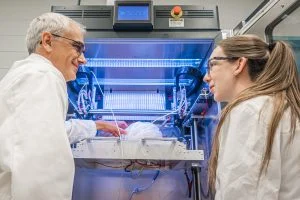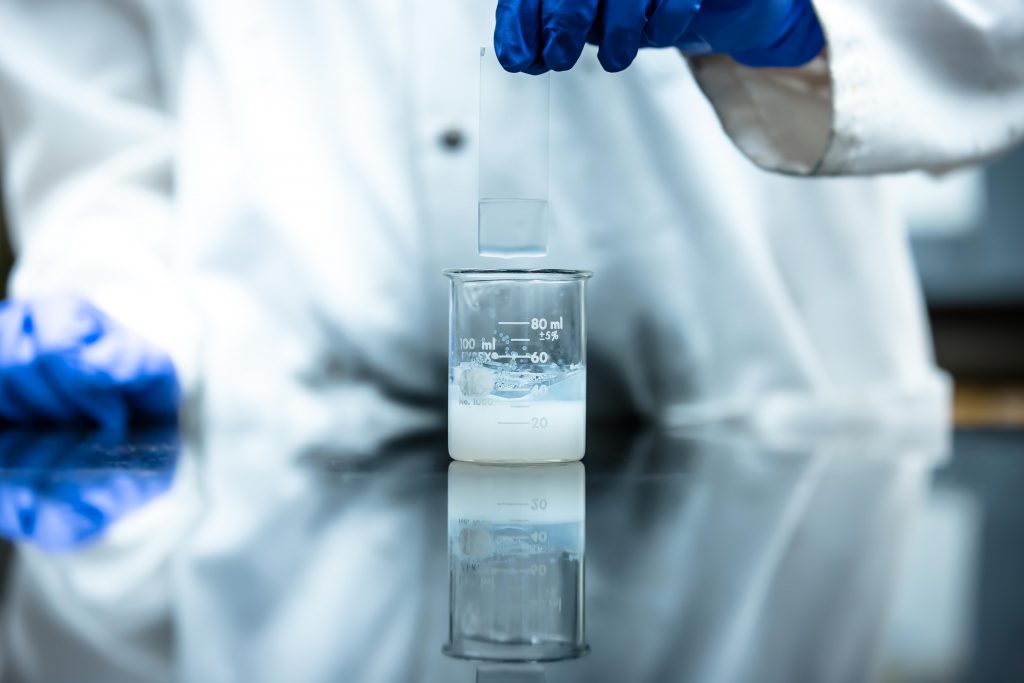Coalia œuvre au développement de matériaux avancés. Un matériau avancé peut être défini comme tout nouveau matériau ou matériau significativement amélioré qui permet d’obtenir un avantage marqué du point de vue des propriétés physico-chimiques et/ ou de la performance (structurale ou fonctionnelle) comparativement aux matériaux conventionnels.
INNOVATIONS TECHNOLOGIQUES
- Synthèse et fonctionnalisation de matériaux
- Développement de nanostructures
- Mise en oeuvre de nanomatériaux et de nanocomposites
- Matériaux avancés pour la capture et le stockage de CO2
- Développement de procédés novateurs
- Caractérisation multi-échelle physico-chimique
- Transfert de technologie à l’échelle industrielle


EXEMPLES DE MATÉRIAUX ÉTUDIÉS
- Nanocharges (métalliques, céramiques, carbonnées, organiques)
- Résines thermoplastiques ou thermodurcissables
- Polymères liquides en solution
DOMAINES D’APPLICATION
- Biomédical
- Environnement
- Énergie
- Revêtements et emballages
- Construction
- Transports


De 2013 à 2023, la Chaire de recherche industrielle sur les matériaux avancés (CRIMA) misait sur le potentiel des nanomatériaux pour accroître l’avantage concurrentiel de ses partenaires. Elle assurait le transfert de technologies novatrices pour la mise en marché de produits nanocomposites innovants.
La chaire a travaillé avec ses partenaires, notamment NanoXplore, Soucy, Soprema, Silicycle, CelluForce, TEKNA et Salomon, au développement de matériaux innovants pour accroître leur avantage concurrentiel. Elle a assuré le transfert de technologies pour la mise en marché de produits nanocomposites novateurs.
SECTEURS INDUSTRIELS CIBLES
- Énergie
- Construction
- Revêtements et emballages
- Transport terrestre, maritime, aérien et spatial
SUPPORTS AU PROCESSUS D’INNOVATION
- Développement d’affaires
- Renforcement de la chaîne de valeur
- Maillage industriel
- Communication et marketing
- Stratégies de commercialisation
Titulaire : Philipe Bébin, Ph.D., MBA
Partenaires de la chaire




- Développement de billes polymères calibrées pour la purification de liquides et de gaz.
- Amélioration de la dispersion de nanocristaux de cellulose dans les polyoléfines.
- Procédé d’incorporation de graphène dans les thermoplastiques.
- Développement de nouveaux matériaux à base de nanotubes de nitrure de bore.
- Amélioration de la résistance à l’abrasion du UHMWPE.
- Incorporation de matériaux à changement de phase pour une meilleure gestion thermique des bâtiments.

Publications
[1] Hu L, Leclair Έ, Poulin M, Colas F, Baldet P, Vuillaume PY. Clay/Polyethylene Composites with Enhanced Barrier Properties for Seed Storage. Polymers and Polymer Composites 2016; 24:387–94. https://doi.org/10.1177/096739111602400601.
[2] Vuillaume PY, Vachon A, Grey W, Pépin K, Zhang CJ. Compatibilisation of various PLA/thermoplastic elastomer blends with diisocyanate coupling agent. Plastics, Rubber and Composites 2018; 47:95–105. https://doi.org/10.1080/14658011.2018.1439716.
[3] Vachon A, Pépin K, Balampanis E, Veilleux J, Vuillaume PascalY. Compatibilization of PLA/PEBA Blends via Reactive Extrusion: A Comparison of Different Coupling Agents. J Polym Environ 2017; 25:812–27. https://doi.org/10.1007/s10924-016-0860-x.
[4] Vuillaume PY, Zang C, Leclair E, Rochette A, Vachon A. Creating Super‐Tough, Bio‐Based Polylactic Acid Materials: Blending tests with MDI coupling agent yield interesting results. Plastics Engineering 2017; 73:24–7. https://doi.org/10.1002/j.1941-9635.2017.tb01658.x.
[5] Nguyen KQ, Vuillaume PY, Hu L, Vachon A, Diouf-Lewis A, Marcoux P-L, et al. Effect of in situ thermal treatment on ABS parts produced by fused deposition modeling (FDM). Int J Adv Manuf Technol 2024; 135:2273–83. https://doi.org/10.1007/s00170-024-14656-8.
[6] Nguyen KQ, Vuillaume PY, Hu L, Vachon A, Diouf-Lewis A, Marcoux P-L, et al. Effect of in situ thermal treatment on interlayer adhesion of 3D printed polyetherimide (PEI) parts produced by fused deposition modeling (FDM). Materials Today Communications 2024; 39:108588.
[7] Hu L, Pépin K, Bébin P, Leclair É, Colas F, Vuillaume PY. Fluorohectorite/LDPE nanocomposites: The role of organomodifiers and compatibilizer. Can J Chem Eng 2018; 96:1510–7. https://doi.org/10.1002/cjce.23129.
[8] Fiset J, Cellier M, Vuillaume PY. Macroporous geopolymers designed for facile polymers post-infusion. Cement and Concrete Composites 2020; 110:103591.
[9] Foruzanmehr Mr, Vuillaume PY, Elkoun S, Robert M. Physical and mechanical properties of PLA composites reinforced by TiO2 grafted flax fibers. Materials & Design 2016; 106:295–304.
[10] Moradkhani G, Profili J, Destrieux A, Robert M, Laroche G, Elkoun S, et al. Plasma-Enhanced Alginate Pre-Treatment of Short Flax Fibers for Improved Thermo-Mechanical Properties of PLA Composites. Journal of Composites Science 2024; 8:106.
[11] Bayart M, Foruzanmehr MR, Vuillaume PY, Ovlaque P, Robert M, Elkoun S. Poly(lactic acid)/flax composites: effect of surface modification and thermal treatment on interfacial adhesion, crystallization, microstructure, and mechanical properties. Composite Interfaces 2022; 29:17–36. https://doi.org/10.1080/09276440.2021.1884470.
[12] Leblond L, Anagri A, Fiset J, Borget M-Y, Bébin P, Dumais N, et al. Polypropylene fabric coated with branched polyethyleneimine derivatives for high antiviral activity. RSC Applied Interfaces 2024; 1:908–19.
[13] Hu L, Vuillaume PY. Reactive compatibilization of polymer blends by coupling agents and interchange catalysts. compatibilization of polymer blends, Elsevier; 2020, p. 205–48.
[14] Nguyen KQ, Vuillaume PY, Hu L, López-Beceiro J, Cousin P, Elkoun S, et al. Recycled, bio-based, and blended composite materials for 3D printing filament: Pros and cons—A Review. Materials Sciences and Applications 2023; 14:148–85.
[15] Vuillaume PY, Mokrini A, Robitaille L, Bébin P, Leblond L. Solid-State Characterization of Heteropolyacid-Phyllosilicate Complexes: Structural, Morphological and Thermal Properties. J Mater Sci Res 2023; 12:36.
[16] Foruzanmehr Mr, Boulos L, Vuillaume PY, Elkoun S, Robert M. The Effect of cellulose oxidation on interfacial bonding of nano-TiO2 coating to flax fibers. Cellulose 2017; 24:1529–42. https://doi.org/10.1007/s10570-016-1185-6.
[17] Foruzanmehr Mr, Vuillaume PY, Robert M, Elkoun S. The effect of grafting a nano-TiO2 thin film on physical and mechanical properties of cellulosic natural fibers. Materials & Design 2015; 85:671–8.


